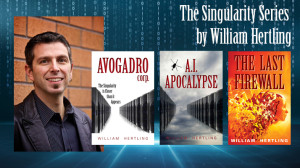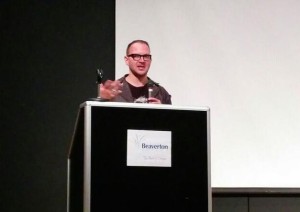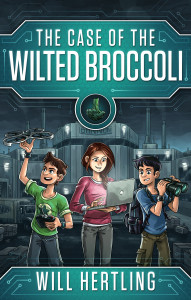Mike R. Underwood has a nice piece up about 25 Secrets of Publishing Revealed. If you’re a writer, go check it out. I know Mike from an online writers’ community we’re both part of, and I enjoyed his novel Geekomancy.
I don’t disagree with anything Mike said, but I do think his article comes from traditional publishing viewpoint. So after you’ve read his article, come back here and read a few of my reactions. (I’ve only addressed a few of his 25 items. For the most part, I think he’s spot on.)
3) GATEKEEPERS: YOU KEEP SAYING THAT WORD
Mike says that gatekeepers aren’t there to keep you out, but to find content of the right fit for their publisher. He gives brief mention to the option of self-publishing.
I want to emphasize: self-publishing is a very viable choice that has a whole set of advantages and disadvantages compared to traditional publishing, and shouldn’t be seen only as a fallback alternative. Self-publishing gives you the control over the creative, production, and marketing processes. Want to hire your choice of talent to edit, design, or create a cover? Want to keep a greater percentage of the royalties? Want to develop business skills? You can when you’re the publisher.
Evaluating traditional versus indie publishing is asking if you want to be the employee of a big company (little control over what happens, but lots of people to back you up) versus an entrepreneur starting your own business.
5) AGENTS ARE FREAKING KEY, BUT YOU CAN GO IT ALONE IF YOU REALLY WANT
They’re key if you go the route of traditional publishing, but less important if you’re indie. However, even if you’re indie, you’ll still want an agent to help you sell foreign translation rights, film rights, etc. It’s especially challenging to reach out to publishers in other countries without an agent. If you are indie, make sure you’re agent is indie-friendly and understands you’ll be pursuing a mix of traditional and indie publication. Your contract should clarify that the agent does not get a percentage of royalties for those titles you’ve indie published.
7) BOOKSELLERS ARE AWESOME, BUT THEY HAVE TO BE PROFITABLE, TOO
In this point Mike argues that sometimes a bookseller will screw over (his words) a particular author or genre, and “that’s why we, as authors, are well-advised to develop a diversified publishing portfolio for ourselves and to support a diverse bookselling landscape, so that no one part of our business, no one retailer, no one project, has too much control over our overall publishing fate.”
I agree heartily, and this is an even bigger danger for indies, most of whom get the majority of their royalties from Amazon. I get more than 90% of my book income from Amazon. If Amazon changes their royalty structure (and they’ve given hints of doing so), my royalties and those of other indies could drop in half. They’ve already taken steps to drive exclusivity, reserving the highest royalties for those people who do Kindle-exclusive ebooks, and preferring Kindle-exclusive titles when doing promotions.
It’s also challenging for indies to get into bookstores, but that’s a topic worthy of a whole post by itself.
9) THE TRADITIONAL PUBLISHING JAEGER
Mike said about this: “If you sell a book to a major publisher, you’re agreeing to give over a big chunk of the book’s income in order to hire an army to go to bat for your book. If you sell to a smaller publisher, you’re hiring a smaller, more focused army. A traditional publisher includes the following people helping to make your book amazing and to sell it: editor, publicist, sales representatives, sales managers, marketers, library representatives, book designers, artists, layout artists, inventory staff, finance & royalties workers, and hundreds more positions in a bigger house.”
Yes, but… That big army can on occasion be an army of mediocrity. That can happen if everyone at the publisher is just so-so in their talent and skill, or because the A-team got put on someone else’s book, and you got the B-team or the C-team, or the just-hired intern who has no idea what they’re doing. (Surely we’ve all experience the pockets of abyss that can exist inside bigger companies.)
This is my biggest fear with traditional publishing compared to the indie world. In the indie world, you can pick the people who work on your book, whether that’s hiring a great editor, an amazing cover designer. Or you can choose to do the work yourself, taking charge of social media, advertising, and marketing. The danger here is that indies often don’t know what they don’t know. You might not know you need a proofreader after your copyeditor, or you might have hired an inferior editor and can’t judge that yourself. But in the indie world, if you do make a mistake, because you’re still in control, you can fix it: hire someone better, or reedit the book after it’s already gone out. It’s very rare to find that in the traditional publishing world: forget about saying “let’s try a new cover” after the book has been out two months.
10) TRADITIONAL PUBLISHING IS SLOW FOR A REASON
Among other points, Mike says, “The reason publishing is slow is that it’s big, and it’s powerful. In order to align the dozens, hundreds, or thousands of employees behind a book as part of a publisher’s season, there’s a ton of coordination and steps to go through to make it a powerful butt-kicking sales machine.”
Yes, there are reasons it’s slow, but they aren’t all good, and they aren’t all necessary. I’ve personally experienced this, working in large and small companies. Large companies have huge amounts of overhead as they task-switch between projects, wait on constrained resources (maybe the one interior-layout designer), or just drop the ball. In fact, the best teams inside large companies are usually the smallest, most focused ones. A small, nimble, focused team can do in a couple of months what might take a large organization a year to do. And they’ll usually do it with higher quality and better results.
11) COVERS ARE FOR THE PUBLISHER
Mike argues that covers are for the buyer, not the author, and that it’s best to turn that over to the people who know best: a designer with experience with book covers. With a traditional publisher, authors get zero input into the cover design.
I agree that an author should never design their own cover (unless they happen to be a talented book cover designer). But an author should be familiar with their genre and know enough to be able to pick something that matches their genre and yet stands out.
Many long-term cover designers are thinking first-and-foremost about how a cover will look as a 6×9 paperback. But if the majority of your sales will be online (as they are for many genre writers), then the cover must be amazing not at 6″ x 9″, but at 100 pixels by 150 pixels: less than an inch tall. That requires a whole other set of design principles.
I don’t want to sound like a broken record, but it’s not a given that a traditional publisher will give you the best cover. You might be allocated a cheaper cover, or an designer who isn’t designing for icon-sized covers, or someone who doesn’t know your genre. You must become educated enough to know what works and doesn’t work and involve yourself in the process of approving the cover. (Of course, as an indie you’ll get total control, and with a publisher you’ll have only minor influence.)
13) MAKING FRIENDS IS THE BEST MARKETING
I completely agree with what Mike said here, and just want to add that it’s fun, too!
Unless many other types of work, writing is innately a solitary activity. So you must take steps to make it social. Find a local community and an online community. Take writing classes to meet people, attend your local conventions for writers, and tell people about what you do.
16) YOU HAVE TO LEARN HOW TO PITCH YOUR BOOK
In this point Mike talks about the art of hand-selling: talking to people one-on-one at conventions and bookstores to convince them to buy your book.
I think handselling is great, but I’d be cautious about getting too distracted by it. I see a lot of authors put a tremendous amount of time into conventions or bookstores, and then go on to sell anywhere from two to five copies. Investing a weekend of work to sell a few copies isn’t a great ROI. Don’t get me wrong, I think it’s fine to do this and it might be fun. But I see it’s as something you do mostly for the fun of it.
If you want to sell books, I think it makes more sense to focus on activities with a bigger return-on-investment. If you had a weekend’s worth of time, could you sell a hundred or a thousand books? Probably not at a convention handselling to one person at a time, but you could do it with online advertising, clever promotional strategies, and so forth.
Focus on what scales, because your goal is to sell thousands of books, not dozens.
20) GOTTA GET PAID – HOW ADVANCES AND ROYALTIES WORK
Mike explained how traditional publishers work. Most of the money you’re likely to earn comes from advances, which are paid out in thirds when the contract is signed, the final manuscript is turned over, and the book is published. Royalties (if you earn any) will usually get paid either annually or semiannually. You typically won’t know how many books you’ve sold until you get these annual or semiannual reports. Which means that if you want to know whether you should be celebrating you won’t know for a very long time. The long feedback times also make it difficult to determine the effectiveness of promotional efforts.
With indie-published books, all of the money you earn will come as royalties after the book is sold. You’ll typically get paid monthly (except for Smashwords who pays quarterly), and royalties will lag by about two months: so you’ll get paid at the end of March for the books you sold in January.
You’ll see your sales in real time, so that you can know by midnight how many books you sold that day. This means that if you run an advertising campaign, talk about your book at a convention, or get a big blog mention, you’ll immediately know the sales impact. This kind of continuous feedback helps you optimize what you to do market and promote your books. (And it’s very rare to find a big publisher who is doing this kind of continuous optimization.)
24) IT TAKES A LONG TIME TO GET GOOD
Mike argues that one downside to the indie world is that it takes a long time to become good and that new authors can put work out that is bad. Hence, maybe it makes sense to write for six or seven years, and get a couple of novels written before publishing the first one.
I agree that we get better by writing, but sometimes a first novel is good-enough. It might not be great, and it might suffer from many first-timer mistakes, but it also might contain just enough to good bits to really resonate with an audience. Avogadro Corp was my first novel, and although it went out with errors and poor writing, it’s also been very, very popular. Should I have stuck in a trunk and not published it? I think that would have been a mistake.
I come from a software background, and in particular use agile and lean methodologies. That means getting out a minimal product and then getting user (or for books, reader) feedback on it. In the case of Avogadro Corp, I received feedback after it was published, and then made improvements to it. Two years later I’m still making improvements (this last round of revisions took six months and included both copyediting and proofreading improvements).
In sum, I liked Mike’s article and agree with nearly everything he said. I hope you’ll find these additional points from the indie-perspective helpful.








